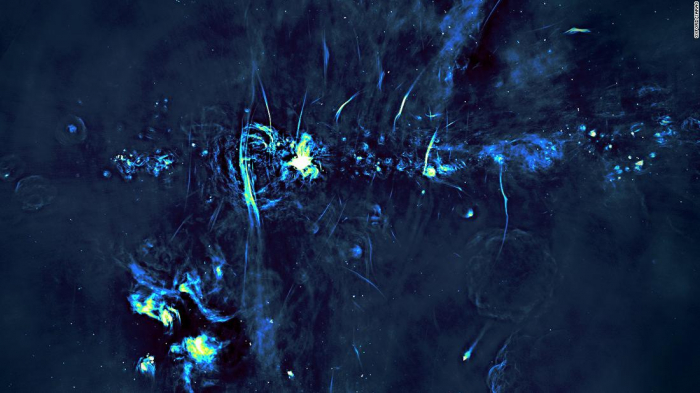A new study describing the balloons published Wednesday in the journal Nature.
To understand the scale of these giant bubbles, they extend for hundreds of light-years above and below the center of the Milky Way. But how did they get there?
Researchers believe that an energetic burst occurred near the supermassive black hole at the center of the galaxy millions of years ago, resulting in these structures. The twin balloons likely formed after an explosion or eruption blew through the interstellar medium in opposite directions. The interstellar medium is the space between star systems in a galaxy.
The researchers think the structures are a few million years old.
"The center of our galaxy is relatively calm when compared to other galaxies with very active central black holes," said Ian Heywood, study author and Hintz Fellow at the University of Oxford. "Even so, the Milky Way's central black hole can become uncharacteristically active, flaring up as it periodically devours massive clumps of dust and gas. It's possible that one such feeding frenzy triggered powerful outbursts that inflated this previously unseen feature."
Other scenarios are also possible, including "a massive burst of star formation which sent shockwaves careening through the galactic center," said William Cotton, study co-author from the National Radio Astronomy Observatory in Charlottesville, Virginia.
"In effect, this inflated energetic bubbles in the hot, ionized gas near the galactic center, energizing it and generating radio waves which we could eventually detect here on Earth," he said.
Although the structures are so massive, the center of the galaxy is difficult for us to see because thick dust clouds obscure the view of our telescopes. But the South African Radio Astronomy Observatory MeerKAT telescope was able to detect the radio wavelength emanating from the area.
The researchers used the telescope to map parts of the galactic center. There, electrons accelerate when they encounter powerful magnetic fields. In turn, this creates a signal that the telescope can track. In addition to its imaging technology, the telescope is also incredibly sensitive.
"It is extremely exciting to be able to peer at the center of the Galaxy with such high definition and precision," said Steve Balbus, study co-author and head of astrophysics at the University of Oxford. "This is the nearest supermassive black hole to us in the Universe, and MeerKAT has provided us with front row center seats. We are going to learn an enormous amount about how black holes feed themselves and how they influence their environments."
The data gathered from MeerKAT is helping astronomers piece together a galactic fossil record, which will lead to a greater understanding of the history of the galactic center and its supermassive black hole.
The violent event that helped create the balloons could also be the source of the electrons creating the radio signal. About 35 years ago, Northwestern University astronomy and physics professor Farhad Yusef-Zadeh discovered a mysterious population of large, thread-like magnetic filaments in the galactic center, 25,000 light-years from Earth. The filaments are about one light-year wide each, and tens of light-years long. They've never been observed anywhere else.
"The radio bubbles discovered with MeerKAT now shed light on the origin of the filaments. Almost all of the more than one hundred filaments are confined by the radio bubbles," said Yusef-Zadeh, who is also a senior author of the study.
The researchers believe this discovery, and the MeerKAT telescope, herald a new era of radio astronomy.
"These enormous bubbles have until now been hidden by the glare of extremely bright radio emission from the center of the galaxy," said Fernando Camilo, study co-author at the South African Radio Astronomy Observatory.
"Teasing out the bubbles from the background 'noise' was a technical tour de force, only made possible by MeerKAT's unique characteristics and propitious location in the Southern hemisphere."
















































